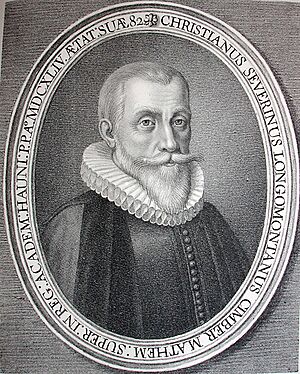Christen Sørensen Longomontanus facts for kids
Quick facts for kids
Christen Sørensen Longomontanus
|
|
|---|---|

Christen Sørensen Longomontanus
|
|
| Born | 4 October 1562 |
| Died | 8 October 1647 (aged 85) |
| Nationality | Danish |
| Alma mater | University of Rostock |
| Scientific career | |
| Fields | Astronomy |
| Institutions | University of Copenhagen |
Christen Sørensen Longomontanus (born 4 October 1562 – died 8 October 1647) was a famous Danish astronomer. He was also known as Longberg or Severin.
His last name, Longomontanus, was a Latin version of the name of his home village, Lomborg, in Jutland, Denmark.
Contents
Christen's Early Life and Education
Christen's father, Søren, passed away when Christen was only eight years old. An uncle helped him get an education in Lemvig. But after three years, Christen had to go back home to help his mother work on their farm.
His mother agreed that he could study during the winter with the local clergyman. This continued until 1577. Because some relatives were not kind to him, and because he really wanted to learn more, he decided to leave home. He went to Viborg.
In Viborg, Christen attended a grammar school. He worked hard as a laborer to pay for his studies. By 1588, he had gained a great reputation for being smart and capable. He then moved to Copenhagen.
Working with Tycho Brahe
In 1589, the famous astronomer Tycho Brahe hired Christen as his assistant. Christen worked at Tycho's large observatory, Uraniborg, for eight years. He was a huge help to Tycho.
Christen greatly admired Tycho Brahe and always supported his ideas about the universe. However, they did have one big disagreement: Tycho believed the Earth stayed still, but Christen thought it rotated every day.
During this time, Johannes Kepler also joined them. Together, they tried to figure out how to accurately predict the positions of planets. Longomontanus used the planet Mars as a model for his work.
Christen left Tycho Brahe in 1597 to study at universities in Germany. He rejoined Tycho in Prague in 1600. After helping to finish Tycho's ideas about the Moon, he returned home to Denmark.
Becoming a Professor
Tycho Brahe sadly passed away in 1601. Many expected Longomontanus to take over as the Emperor's mathematician, as he was Tycho's preferred choice. However, Longomontanus was in Denmark at the time, and Johannes Kepler was there, so Kepler got the job.
Longomontanus visited Frauenburg, where Nicolaus Copernicus had made his observations. He earned a master's degree from the University of Rostock. Back in Copenhagen, he found a supporter in Christian Friis, a powerful Danish official.
In 1603, Longomontanus became the head of the school in Viborg. Two years later, he was chosen to be a professor at the University of Copenhagen. By 1607, he became the head of the mathematics department. He held this important position until he died in 1647.
Contributions to Astronomy
Longomontanus was a very dedicated scientist. He helped to build the Rundetårn (a tall astronomical tower in Copenhagen) starting in 1632, but he passed away before it was finished.
His biggest contribution to science was helping to make Tycho Brahe's model of the universe widely accepted. This model, called the geoheliocentric model, said that the Sun and Moon orbit the Earth, but the other planets orbit the Sun.
When Tycho died in 1601, his work was not finished. Longomontanus took on the huge task of organizing Tycho's observations and presenting them in a major book called Astronomia Danica (1622). This book was seen as Tycho's final work and was very popular in the 1600s.
Unlike Tycho's original model, Longomontanus's version of the geoheliocentric system included the Earth spinning on its axis every day. This is why it is sometimes called the 'semi-Tychonic' system. The book was reprinted many times, showing how important and popular it was.
Longomontanus had also worked with Kepler on calculating the Martian orbit. His calculations for Mars in his geoheliocentric model were very accurate, even before Kepler used elliptical orbits in his own heliocentric system.
Some historians believe Kepler's 1627 Rudolphine Tables were the most accurate at the time. However, it has never been proven that they were more accurate than Longomontanus’s 1622 Danish Astronomy tables, which were also based on Tycho’s observations.
Things He Got Wrong
Like many scientists of his time, Longomontanus had some ideas that we now know are incorrect. For example, he believed that comets were signs of bad things to come. He also thought he had solved the ancient math problem of "squaring the circle." This means trying to draw a square with the exact same area as a circle using only a compass and straightedge. He found a value for pi (π) that was close but not perfectly accurate. Other mathematicians tried to explain his mistake, but he stuck to his belief.
Eponymy
- The lunar crater Longomontanus on the Moon is named after him. It is located near the Tycho crater.
See also
 In Spanish: Christen Sørensen Longomontanus para niños
In Spanish: Christen Sørensen Longomontanus para niños

